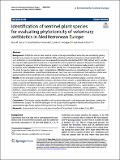Por favor, use este identificador para citar o enlazar a este item:
http://hdl.handle.net/10261/271339COMPARTIR / EXPORTAR:
 SHARE SHARE
 CORE
BASE CORE
BASE
|
|
| Visualizar otros formatos: MARC | Dublin Core | RDF | ORE | MODS | METS | DIDL | DATACITE | |

| Título: | Identification of sentinel plant species for evaluating phytotoxicity of veterinary antibiotics in Mediterranean Europe |
Autor: | García, Rosa M.; Martínez-Fernández, Jesús CSIC ORCID ; Rodríguez, Antonio CSIC; Torre Reoyo, Ana de la CSIC ORCID | Palabras clave: | Agricultural land Crop Environmental risk assessment Pasture land Spatial analysis Wild |
Fecha de publicación: | 1-dic-2022 | Editor: | Springer Nature | Citación: | Environmental Sciences Europe 34 (1): 37 (2022) | Resumen: | Background: Antibiotics used to treat livestock species enter agricultural fields when they are excreted by grazing animals or are present in manure that is added to fields as fertiliser. In the European Union, the potential effects of such antibiotics on terrestrial plants must be evaluated following the standardised OECD 208 method, which specifies the crop and wild species that should serve as “sentinels” for assessing antibiotic exposure. The present study aimed to compare this approved list of sentinel species against crop and wild plant species actually present in agricultural and pasture lands in Mediterranean Europe in order to identify the most appropriate sentinel plants for the region. The study focused on Spain as a region representative of Mediterranean Europe. Georeferenced layers for wild plant species and cultivated areas (crops), livestock density and land cover were combined, and then selection criteria were applied, leading to the identification of sentinel crop and wild species for crop land and pasture scenarios. Results: In the crop land scenario, the sentinel crop species were barley (Hordeum vulgare L.), wheat (Triticum spp.), corn (Zea mays L), sunflower (Helianthus annuus L.), dried pea (Pisum sativum L.), alfalfa (Medicago sativa L.), vetch (Vicia sativa L.), oilseed rape (Brassica napus L.) and sugar beet (Saccharum officinarum L.), all of them listed in the OECD 208 method with the exception of alfalfa; the sentinel wild species were Papaver rhoeas L., Galium aparine L. and Chenopodium album L. In the pasture scenario, sentinel wild species were Bromus tectorum L., Agrostis capillaris L., Trifolium pratense L., Lotus corniculatus L. and Galium aparine L. The following common weed species in field boundaries or in pasture lands also emerged as potential sentinel species for risk assessment, even though they are not listed in the OECD 208 method: Sonchus oleraceus L., Avena sterilis L., Dactylis glomerata L., Hordeum murinum L. and Lolium rigidum Gaudin. Conclusions: The sentinel species identified in this study may be useful in risk assessment procedures covering the Mediterranean Europe. The method developed for this study could be applied to identify sentinel species for other representative agroclimatic regions in Europe (such as Atlantic and Continental). | Descripción: | 16 Pág. | Versión del editor: | https://doi.org/10.1186/s12302-022-00608-0 | URI: | http://hdl.handle.net/10261/271339 | DOI: | 10.1186/s12302-022-00608-0 | ISSN: | 2190-4707 |
| Aparece en las colecciones: | (INIA) Artículos |
Ficheros en este ítem:
| Fichero | Descripción | Tamaño | Formato | |
|---|---|---|---|---|
| Identification-of-sentinel-plant-species-for-evaluating.pdf | artículo | 1,93 MB | Adobe PDF |  Visualizar/Abrir |
CORE Recommender
Page view(s)
52
checked on 07-may-2024
Download(s)
33
checked on 07-may-2024
Google ScholarTM
Check
Altmetric
Altmetric
Este item está licenciado bajo una Licencia Creative Commons

